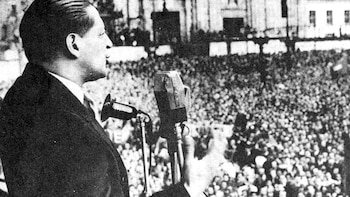
It was noon on April 9, 1948, when several shots shook the center of Bogotá, the pigeons flew, but no one knew their origin, minutes later it was confirmed that Jorge Eliécer Gaitan, the leader of the liberal party who signed up as one of the main candidates, had been assassinated in the midst of political randomness Jorge Eliécer Gaitan, the leader of the liberal party who was one of the main candidates, to stay with the presidency of the Republic of Colombia. This fact marked a historical milestone in the country's memory and as a result of it, a wave of violence unleashed that today still polarizes the nation.

74 years ago, within the framework of the government of Mariano Ospina Pérez, the important political leader named as 'El Caudillo Liberal' fell, who was directly opposed to the oligarchy and the right bank in the country's leadership. Some pointed out that the motive for the murder linked Juan Roa Sierra, a bricklayer who was allegedly the one who shot Gaitan's humanity, who was dragged throughout the seventh race and riddled by the crowd mourning the death of his hero. The lynching was rugged, according to the accounts of some witnesses.
The media were taken over by some leaders of the Liberal Party, Mariano Ospina immediately sent the police force and the army to take to the streets, there were even snipers with rifles who tried to stop the Protestant mass. This led the supporters of liberalism to go out to the main squares of the country with machetes and blunt objects. Bogotá was besieged by the conflict; the tram was torn down and incinerated, as were various institutional bodies.
The riots lasted approximately three days, while protesters demand the president's resignation. For the upcoming elections, the liberals did not present a candidate, which is why Laureano Gómez ascended calmly, however, within this period, the phenomenon of violence increased in both rural and urban areas, the streets were not the same again, the smoke that permeated on the afternoon of April 9, left his evidence with the lags of black spots on the walls.

This event left around 3,000 dead, according to the unofficial figures that were exposed by different agencies. At the time the bodies were laid in the streets, the forensic centers took up their capacity, in the midst of the belligerence innocents fell, who, due to political passion, took to the streets to defend their ideal.
This regrettable event left the country divided, in the midst of the well-known bipartisan war; liberals and conservatives generated hatred for each other, violence shifted from countryside to cities, and the remarks were continuous, since the military in one of the two parties was a source of stigmatization. In rural areas, after several years of war and despite General Rojas Pinilla's attempts to end the conflict through general amnesty, the liberal guerrillas surrendered their weapons, but it was not for long, as some groups kept them and moved to the mountains to organize the already well-known guerrillas, which Today they leave their aftermath; FARC, ELN, EPL, among others, turned their speech into the sound of bullets, under the influence of Soviet, Cuban and even Maoist tendencies, based on the revolution.
After the creation of these armed movements, around the 1990s, political groups such as the Patriotic Union also emerged, which subsequently became a sector constantly being scourged by violence, becoming the largest genocide in the country, with around 4,153 people killed and missing. As a reason to commemorate this whole sequel of events, April 9 was declared the Day of Historical Memory and Solidarity with the Victims of the Armed Conflict, by law 1448 of 2011.
KEEP READING:
Últimas Noticias
Debanhi Escobar: they secured the motel where she was found lifeless in a cistern
Members of the Specialized Prosecutor's Office in Nuevo León secured the Nueva Castilla Motel as part of the investigations into the case

The oldest person in the world died at the age of 119
Kane Tanaka lived in Japan. She was born six months earlier than George Orwell, the same year that the Wright brothers first flew, and Marie Curie became the first woman to win a Nobel Prize

Macabre find in CDMX: they left a body bagged and tied in a taxi
The body was left in the back seats of the car. It was covered with black bags and tied with industrial tape
The eagles of America will face Manchester City in a duel of legends. Here are the details
The top Mexican football champion will play a match with Pep Guardiola's squad in the Lone Star Cup

Why is it good to bring dogs out to know the world when they are puppies
A so-called protection against the spread of diseases threatens the integral development of dogs




